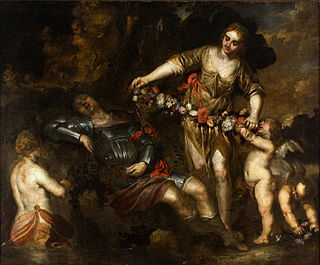Related Research Articles
Giovanni Benedetto Castiglione was an Italian Baroque painter, printmaker and draftsman, of the Genoese school. He is best known now for his etchings, and as the inventor of the printmaking technique of monotyping. He was known as Il Grechetto in Italy and in France as Le Benédette.

Luca Cambiaso was an Italian painter and draughtsman and the leading artist in Genoa in the 16th century. He is considered the founder of the Genoese school who established the local tradition of historical fresco painting through his many decorations of Genoese churches and palaces. He produced a number of poetic night scenes. He was a prolific draughtsman who sometimes reduced figures to geometric forms. He was familiarly known as Lucchetto da Genova.
Bernardo Castello (1557–1629) was an Italian painter of the late-Mannerist style, active mainly in Genoa and Liguria. He is mainly known as a portrait and historical painter.

Alessandro Magnasco, also known as il Lissandrino, was an Italian late-Baroque painter active mostly in Milan and Genoa. He is best known for stylized, fantastic, often phantasmagoric genre or landscape scenes. Magnasco's distinctive style is characterized by fragmented forms rendered with swift brushstrokes and darting flashes of light.

LudovicoBrea was an Italian painter of the Renaissance, active mainly in and near Genoa.

Paolo de Matteis was an Italian painter.

Giovanni Battista Carlone (1603–1684) was an Italian painter of the Baroque period, active mainly in Genoa.

Giovanni Bernardino Azzolini was an Italian painter and sculptor who continued painting in a late-Mannerist style, mainly active in Naples and Genoa. He is also known by Azzolino or Mazzolini or Asoleni.
Giuseppe Badaracco (1588–1657), also called “Il Sordo”, was an Italian painter of the Baroque period, active mainly in Genoa, in Liguria and in the island of Corsica.

Giacomo Boni was an Italian painter of the late-Baroque period, active mainly in Genoa.
Cesare Corte (1554–1613) was an Italian painter of the Renaissance period, active mainly in his natal city of Genoa.

Francesco Costa (1672–1740) was an Italian painter of the late-Baroque period, active mainly in his Native Genoa. He was the pupil of the painter Gregorio de Ferrari in Genoa, and later of Antonio Maria Haffner. He often painted with Giovanni Battista Revello. He painted in the Palazzo Grilli in Pegli. He chiefly painted ornaments and quadratura. He painted a Landscape with Rape of Europa is in the Uffizi.

Alessandro Gherardini was an Italian painter of the Baroque period, active mainly in Florence.

Luigi Miradori was an Italian painter of the Baroque period, active mainly in Cremona.

Giuseppe Palmieri was an Italian painter of the late Baroque period.

Antonio Maria Vassallo was an Italian painter of the Baroque period, active mainly in Genoa, and painting mythologic scenes and still lifes.

Aurelio Lomi was an Italian painter of the late-Renaissance and early-Baroque periods, active mainly in his native town of Pisa, Tuscany.

Carlo Giuseppe Ratti (1737–1795) was an Italian art biographer and painter of the late-Baroque period. He was a pupil of the painter Giovanni Agostino Ratti. Born in Savona, he moved to Rome where he befriended Anton Raphael Mengs and Pompeo Batoni. He died in Genoa, where he labored for many years.

Giovanni Maria delle Piane was an aristocratic Genovese who served as primary court painter for over 60 years in the late-Baroque period. He is also known as "il Molinaretto".

Pier-Francesco Sacchi was an Italian painter of the Renaissance period.
References
- Farquhar, Maria (1855). Ralph Nicholson Wornum (ed.). Biographical catalogue of the principal Italian painters. London: Woodfall & Kinder. p. 15.